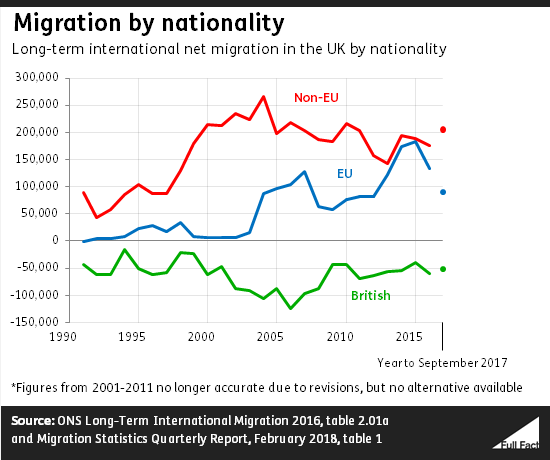Immigration, sovereignty, and the NHS. These became the three pillars upon which the Brexit temple was built for worship. Farage’s rhetoric was particularly anti-immigrant, with his ‘breaking point’ billboard causing particular controversy. That’s not to say people didn’t have a right to be concerned about levels of immigration, the ideal level of immigration isn’t exactly set in stone, it depends on the type of country and economy that you want to build.
The rhetoric that has been pushed by Theresa May since her time in the Home Office has been that Britain can and needs to curb their immigration into the tens of thousands range. In the minds of some anti-immigrant campaigners, the high levels of immigration are straining our public services and diluting British culture, and free movement of people within the EU is a major obstacle to tighter restrictions on immigration. Now, we aren’t saying that the basis for this is rock solid (austerity is a political and economic choice and immigration of a certain level is necessary to keep an economy growing), but people clearly feel strongly about reducing immigration. To that end we decided to take a look at how Britain could have controlled immigration whilst remaining in the European Union.

Current Immigration Numbers
So what do our current immigration figures look like? According to Full Fact,
“An estimated 220,000 citizens from other EU countries immigrated to the UK in the year to September 2017, and about 130,000 emigrated abroad. So EU ‘net migration’ was around 90,000—the lowest level recorded since 2012.”
Now, that figure is only to September, but the 2016 net migration numbers were estimated at 189,000 – so there has been a significant tail off in European citizens coming to the UK. Perhaps that is because of the ‘hostile environment’, because the UK economy is starting to stall comparative to the rest of Europe, because we don’t know what rights EU citizens will have post-Brexit, or because we are unlikely to have any certainty over our future relationship for the foreseeable future.
Despite the drop in EU migration, the non-EU net migration figures haven’t seen quite the same dip. Non-EU migration actually outweighs EU migration and is completely under the control of the UK government, there is no legal obligation to allow the level of immigration to the UK from outside Europe. That isn’t to say that these immigrants have not been of use to the UK, that they have been a drain on resources, immigrants are generally net contributors to the economy. What we wanted to do was highlight the fallacy that leaving the EU is the only way to control immigration – if immigration was genuinely out of control, we could have easily reduced the numbers from outside the EU in an attempt to protect Britain. The reality is that the UK government acknowledges the utility and contributions of these migrants.

Citizens’ Rights Directive
Now we can turn our attention to the ways in which it is possible to curb immigration within the EU. The Citizens’ Rights Directive, or Free Movement Directive, outlines the rights of free movement within the EEA (European Economic Area), that’s the (current) 28 EU member states, Iceland, Norway, and Liechtenstein. It gives citizens of these nations the right of free movement and residence across the area as long as they are not an undue burden on the country of residence. The right of residence becomes permanent after five years and the rights are extended to close family members who are not EEA citizens.
The treaty states that:
(1) Citizenship of the Union confers on every citizen of the Union a primary and individual right
to move and reside freely within the territory of the Member States, subject to the limitations
and conditions laid down in the Treaty and to the measures adopted to give it effect.
To be covered by the European right of free movement, the individual needs to exercise one of the four treaty rights:
- working as an employee (this includes looking for work for a reasonable amount of time),
- working as a self-employed person,
- studying,
- being self-sufficient or retired.
What Does Unreasonable Burden Mean?
The Citizens’ Rights Directive outlines that individuals should not “become an unreasonable burden on the social assistance system of the host Member State during an initial period of residence.” Anyone is permitted to stay for up to three months, at which point they must satisfy one of several conditions listed above to allow them to stay in the country beyond that period. They may be asked to register with the authorities to confirm the legality of their residence.
For example, in Belgium, if an individual is no longer working, self-employed, studying, or if they no longer have
‘sufficient resources’ and become an ‘unreasonable burden’ on the social system, they can be asked to leave. They won’t be physically thrown out or deported, but they stop receiving any social benefits or welfare. In 2014, residence permits of 2,042 EU citizens (and their family members) living in Belgium were rescinded by the Belgian authorities. That number fell to 1,700 in 2015.
In 2007, Belgium even amended the legislation to be more considerate of personal circumstances, the nature of their employment, and the number of dependents in the family.
The idea was to help counter “social tourism” that can place a strain on a country’s welfare system. Belgian Immigration Office’s Geert de Vulder remarked,
“If they don’t contribute by themselves to the social system or they never have contributed to the Belgian social system, they only get benefits from it, then we will withdraw the residence permit,”
If immigration was a central part of the Brexit vote and Conservative policy, why did the UK government not attempt to reduce immigration through the means available to them?
If you enjoyed what you read here you can follow us on Facebook, Twitter, and Instagram to keep up to date with everything we are covering, or sign up to our mailing list here! If you want to hear more from us you can check out our podcast, Chatter, or subscribe to us on iTunes here.









July 23, 2018 at 8:18 am[…] Josh Hamilton on July 23, 2018 This post was originally published on this […]
July 31, 2018 at 6:01 pm[…] There is no reason to believe that ‘taking back control’ of our borders will make any significant impact upon immigration numbers. According to Full Fact, non-EU migrants have made up a higher proportion of immigrants to the UK than EU migrants for more than a decade (even at the height of EU migrant to the UK). The UK government could easily have attempted to restrict immigration numbers by introducing stricter controls on visas, or even by reducing EU migration with the Citizens’ Rights Directive. […]